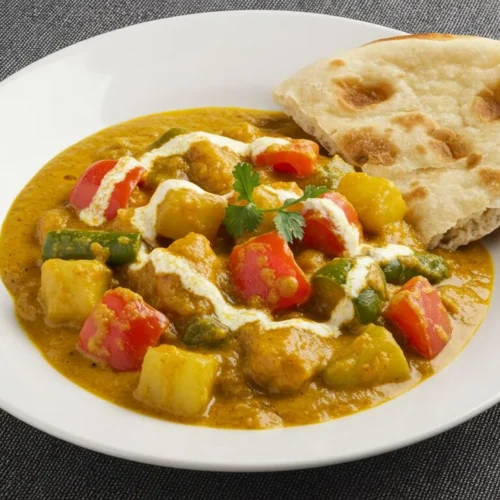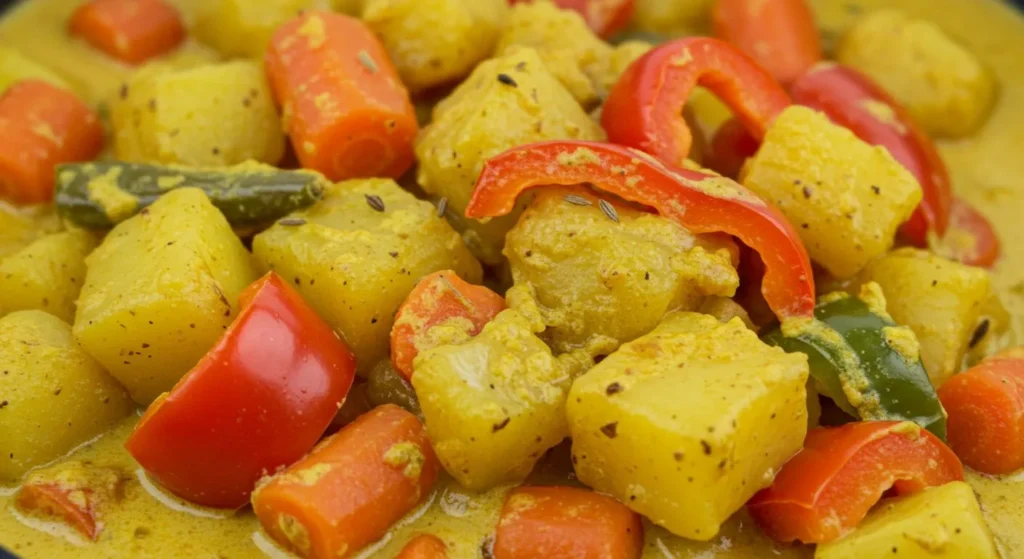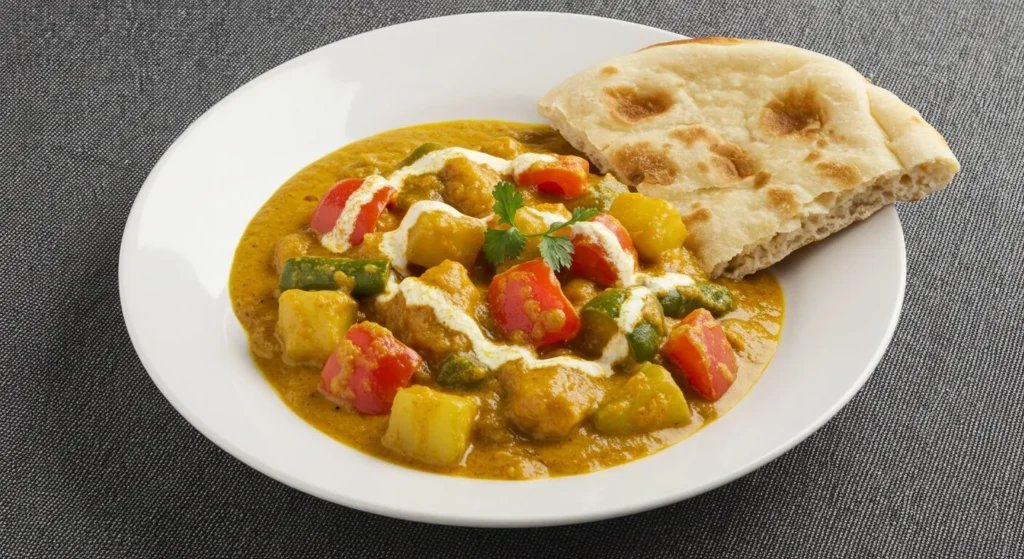
Table of Contents
In today’s fast-paced world, finding meals that balance nutrition, flavor, and convenience can be challenging. Easy Vegetable Curry offers the perfect solution for busy individuals seeking wholesome plant-based options without compromising on taste. This versatile dish combines vibrant vegetables, aromatic spices, and creamy sauces to create a satisfying meal that’s not only delicious but also incredibly simple to prepare. Whether you’re a seasoned home cook or a novice in the kitchen, this guide will walk you through everything you need to know about creating the perfect vegetable curry.
Why Easy Vegetable Curry Should Be Your Go-To Weeknight Meal
The beauty of an easy vegetable curry lies in its adaptability and minimal preparation time. Unlike many elaborate dishes that require hours of cooking and numerous ingredients, a well-crafted vegetable curry can be ready in under 30 minutes while still delivering complex flavors that taste like they’ve been developing for hours. This makes it an ideal choice for weeknight dinners when time and energy are limited but the desire for a nutritious, flavorful meal remains strong.
Moreover, vegetable curries are incredibly versatile. You can use whatever vegetables you have on hand, making them perfect for reducing food waste and maximizing the use of seasonal produce. From hearty root vegetables in winter to fresh summer squashes and peppers, the base recipe can be adjusted throughout the year while maintaining the same comforting essence that makes curry so beloved worldwide.
The Health Benefits of Including Easy Vegetable Curry in Your Diet
An easy vegetable curry isn’t just convenient and delicious—it’s also packed with numerous health benefits. Plant-based diets have been associated with lower risks of heart disease, certain cancers, and type 2 diabetes. By centering your meal around vegetables, you’re increasing your intake of essential vitamins, minerals, and fiber while naturally limiting less healthful components like saturated fat.
Many curry spices also offer significant health advantages. Turmeric, a staple in most curry powders, contains curcumin, a compound with powerful anti-inflammatory and antioxidant properties. Ginger aids digestion and can help reduce nausea, while garlic has been shown to boost immune function and may help lower blood pressure. Consuming these spices regularly through dishes like vegetable curry may contribute to overall well-being and help combat chronic inflammation.
Essential Ingredients for the Perfect Easy Vegetable Curry
Creating a flavorful easy vegetable curry requires a thoughtful combination of vegetables, spices, and a creamy base. Here’s what you’ll need:
Base Vegetables
The foundation of any good vegetable curry consists of aromatics and hearty vegetables that provide substance and absorb flavors well:
- Onions (red or yellow)
- Garlic
- Ginger
- Bell peppers (any color)
- Carrots
- Potatoes or sweet potatoes
- Cauliflower
- Peas
These vegetables create a satisfying texture and serve as the perfect canvas for spices. You can substitute or add other vegetables based on what’s in season or your personal preferences.

Vegetable Curry with Coconut Sauce
Ingredients
- “2 large potatoes diced”,
- “2 medium carrots sliced”,
- “1 cup green peas”
- “1 can coconut milk”
- “1 onion chopped”,
- “2 cloves garlic minced”,
- “1 tablespoon curry powder”
- “1 teaspoon turmeric”
- “1 teaspoon cumin”
- “Salt and pepper to taste”
- “Fresh cilantro for garnish”
Instructions
- “In a large pan, sauté the onion and garlic in oil until softened.”,
- “Add the curry powder, turmeric, and cumin, stirring for 1-2 minutes to release the flavors.”,
- “Add the diced potatoes and carrots, followed by the coconut milk and green peas.”,
- “Simmer for 20-30 minutes, or until vegetables are tender.”,
- “Season with salt and pepper to taste, and garnish with fresh cilantro.”
Curry Spices and Seasonings
The distinct flavor profile of an easy vegetable curry comes from its spice blend. While you can use pre-made curry powder for convenience, creating your own blend offers more control over the final flavor:
- Turmeric
- Cumin
- Coriander
- Garam masala
- Cardamom
- Cinnamon
- Chili powder or fresh chilies (adjust according to your spice tolerance)
- Salt and pepper
Toasting these spices before adding liquids will enhance their flavors and create a more aromatic curry.

Liquid Base Options
For the creamy component that ties everything together:
- Coconut milk
- Tomato sauce or crushed tomatoes
- Vegetable broth
- Plain yogurt (for non-vegan versions)
These provide the necessary liquid for cooking the vegetables while adding richness and depth to your curry.
How to Make Easy Vegetable Curry: Step-by-Step Instructions
Creating the perfect easy vegetable curry is straightforward when you follow these simple steps:
1. Prepare Your Vegetables
Begin by chopping all vegetables into similarly sized pieces to ensure even cooking. For a quick curry, aim for bite-sized chunks rather than large pieces. This not only speeds up the cooking process but also makes the final dish easier to eat.
2. Create an Aromatic Base
Heat 2 tablespoons of oil (coconut, olive, or vegetable) in a large pot or deep skillet over medium heat. Add diced onions and sauté until translucent, about 3-4 minutes. Then add minced garlic and ginger, cooking for another minute until fragrant. This aromatic foundation will infuse the entire curry with flavor.
3. Toast Your Spices
Add your spices to the pot and stir constantly for 30-60 seconds until they become fragrant. Be careful not to burn them, as this can create bitter flavors. If using curry paste instead of powder, add it at this stage and stir to coat the aromatics.

4. Add Vegetables Strategically
Add vegetables in order of cooking time—harder vegetables like carrots and potatoes first, followed by medium-textured ones like bell peppers and cauliflower. Stir to coat everything in the spice mixture.
5. Pour in Your Liquid Base
Add your chosen liquid—coconut milk, tomatoes, broth, or a combination—and bring to a gentle simmer. If using multiple liquids, the typical ratio is 1 can (14 oz) coconut milk, 1 cup crushed tomatoes, and ½ cup broth for a well-balanced curry.
6. Simmer Until Vegetables Are Tender
Cover and simmer for 15-20 minutes, stirring occasionally, until vegetables are tender but not mushy. Add quicker-cooking vegetables like peas or spinach in the last 3-5 minutes.
7. Balance the Flavors
Taste and adjust seasoning as needed. Add a pinch of sugar to balance acidity from tomatoes, a squeeze of lime for brightness, or a little more salt to enhance overall flavors.
8. Garnish and Serve
Finish your easy vegetable curry with fresh cilantro, a dollop of yogurt (if not vegan), or a sprinkle of toasted cashews or almonds for added texture.
Customizing Your Easy Vegetable Curry for Different Dietary Needs
One of the greatest advantages of making an easy vegetable curry is its inherent adaptability to various dietary requirements:
Vegan and Vegetarian Options
Most vegetable curries are naturally vegetarian. To ensure yours is vegan, use coconut milk rather than dairy products and check that any store-bought curry pastes don’t contain fish sauce or shrimp paste.
Gluten-Free Considerations
Vegetable curries are typically gluten-free, but always verify that your curry powder or paste doesn’t contain hidden gluten. Serve with rice or gluten-free flatbreads instead of wheat-based naan.
Low-Carb Variations
For a lower-carb version, skip the potatoes and focus on non-starchy vegetables like cauliflower, bell peppers, zucchini, and greens. Serve over cauliflower rice instead of traditional rice for a complete low-carb meal.
Protein-Rich Additions
While vegetables provide some protein, you can boost the protein content by adding:
- Firm tofu, cubed and pan-fried before adding to the curry
- Chickpeas or lentils
- Tempeh chunks
- Paneer cheese (for non-vegan versions)
These additions transform your easy vegetable curry into a more substantial main dish while maintaining its plant-focused approach.

Time-Saving Tips for Making Easy Vegetable Curry on Busy Weeknights
When time is particularly tight, these strategies can help you get your easy vegetable curry on the table even faster:
Prep Ahead
Chop vegetables and mix spices the night before or during weekend meal prep. Store them separately in the refrigerator until ready to cook.
Use Frozen Vegetables
Pre-cut frozen vegetables eliminate chopping time and work perfectly in curries. A mix of frozen bell peppers, peas, and cauliflower can be added directly to the pot—no thawing necessary.
Invest in Quality Curry Paste
While making your own spice blend offers customization, having a jar of high-quality curry paste on hand can significantly reduce preparation time. Look for pastes with clean ingredients and no artificial additives.
One-Pot Approach
Cook your rice or grain in the same pot after the curry is done by adding it directly to the simmering liquid, creating a one-pot meal that saves on cleanup time.
Batch Cooking
Double or triple the recipe and freeze portions for future meals. Vegetable curry actually improves in flavor after a day or two, making it ideal for meal prepping.
Serving Suggestions to Complement Your Easy Vegetable Curry
An easy vegetable curry can stand alone as a satisfying meal, but these accompaniments elevate it to new heights:
Grain Options
- Basmati rice or brown rice
- Quinoa for added protein
- Cauliflower rice for a low-carb option
- Farro or barley for a hearty, chewy texture
Bread Choices
- Naan bread, particularly garlic naan
- Chapati or roti
- Pita bread
- Gluten-free flatbreads for those with sensitivity
Cooling Condiments
- Raita (yogurt with cucumber and mint)
- Sliced cucumber with lemon juice
- Fresh mint chutney
- Simple green salad with lemon vinaigrette
These accompaniments provide textural contrast and help balance the spices in your curry.
Common Mistakes to Avoid When Making Easy Vegetable Curry
Even an easy vegetable curry can go wrong if you make these common errors:
Not Toasting Spices
Skipping the step of toasting your spices before adding liquid results in less complex flavor. Give those spices at least 30-60 seconds in the hot oil to bloom and release their aromatic compounds.
Overcrowding the Pan
Adding too many vegetables at once can lower the temperature of your pan, causing them to steam rather than sauté. This results in less flavor development. Work in batches if necessary.
Cutting Vegetables Unevenly
Inconsistently sized vegetable pieces will cook at different rates, leaving some overcooked while others remain raw. Aim for uniform cutting to ensure even cooking.
Under-Seasoning
Don’t be shy with salt—it brings out the flavors of both the vegetables and the spices. Season in layers as you cook and adjust at the end.
Rushing the Process
While this is meant to be an easy vegetable curry, giving it at least 15-20 minutes of gentle simmering allows flavors to meld properly. Rushed curries lack depth.
Storing and Reheating Your Easy Vegetable Curry
One of the best aspects of an easy vegetable curry is how well it keeps and often improves with time:
Refrigeration
Store cooled curry in an airtight container in the refrigerator for up to 4 days. The flavors will actually develop and intensify during this time.
Freezing Methods
For longer storage, freeze curry in portion-sized containers for up to 3 months. Thaw overnight in the refrigerator before reheating.
Reheating Techniques
Gently reheat on the stovetop over medium-low heat, adding a splash of water or broth if it’s thickened too much during storage. Stir occasionally to prevent sticking and ensure even warming.
Revitalizing Leftovers
Refresh leftover curry by adding fresh herbs, a squeeze of lemon or lime juice, or a dollop of yogurt when serving. These simple additions can make reheated curry taste freshly made.
 DINNER
DINNER LUNCH
LUNCH CAKE
CAKE BREAKFAST
BREAKFASTFor more amazing recipes, be sure to check out our other sections to explore a variety of ideas that will enrich your cooking experience. Each section offers its own unique flavors to ensure a delightful culinary journey:
- Easy and Quick Recipes: A collection of dishes that guarantee delicious meals with minimal effort and time.
- Healthy Recipes: Discover healthy and delicious options that fit your lifestyle.
- Desserts: A diverse selection of sweets that will add a special touch of sweetness to your table.
- Lunch Recipes: Tasty lunch ideas that you can easily prepare to delight your family.
- Dinner Recipes: Delicious and easy-to-make recipes that will make your dinner a memorable occasion.
Conclusion: Why Easy Vegetable Curry Deserves a Regular Spot in Your Meal Rotation
An easy vegetable curry offers the rare combination of convenience, nutrition, and extraordinary flavor that makes it worthy of regular appearance on your dinner table. With its infinite adaptability, it can transform whatever ingredients you have on hand into a satisfying, nutritious meal in minimal time.
By incorporating this versatile dish into your cooking repertoire, you’re not only expanding your culinary horizons but also introducing a wealth of health-promoting ingredients into your diet. From anti-inflammatory spices to fiber-rich vegetables, every component contributes to your wellbeing while delighting your taste buds.
Whether you’re cooking for one, feeding a family, or entertaining guests, an easy vegetable curry provides a solution that’s simultaneously simple and impressive. Master this adaptable formula, and you’ll have an endlessly customizable meal option for any occasion—proving that plant-based eating can be both accessible and extraordinarily delicious.
